This article and its associated images are based on a poster originally authored by Albert Grau-Carbonell, Carl Schuurmans, Yan Wang, Jan-Piet Wijgergangs, Nick Koumakis, Michiel Hermes, Ad Gerich, and Rut Besseling and presented at ELRIG Drug Discovery 2025 in affiliation with InProcess-LSP.
This poster is being hosted on this website in its raw form, without modifications. It has not undergone peer review but has been reviewed to meet AZoNetwork's editorial quality standards. The information contained is for informational purposes only and should not be considered validated by independent peer assessment.

The size and size distribution of nanomedicines in various (bio)pharmaceutical products, including lipid nanoparticles, recombinant proteins, and antibody drug conjugates, play a significant role in their pharmacokinetic and pharmacodynamic profile in vivo.
These factors influence therapeutic efficacy, immunogenicity, and safety. Here, the capabilities of SR-DLS are presented for real-time, inline particle size characterization of mAb particles during UF/DF processing.
Spatially Resolved DLS (SR-DLS)
Standard Dynamic Light Scattering (DLS) techniques have been used for decades to measure the size of nanoparticles in suspension. However, due to its reliance on the measurement of particle diffusion via standard optics, DLS can only be performed on sufficiently dilute and stagnant nanosuspensions, precluding many applications for direct (inline) monitoring of nanomedicine production processes.
To solve this, InProcess-LSP has developed an innovative combination of low-coherence interferometry and DLS, which allows the fluctuations of scattered light to be spatially resolved from suspensions (Fig. 1). This SR-DLS-based instrument is the NanoFlowSizer.
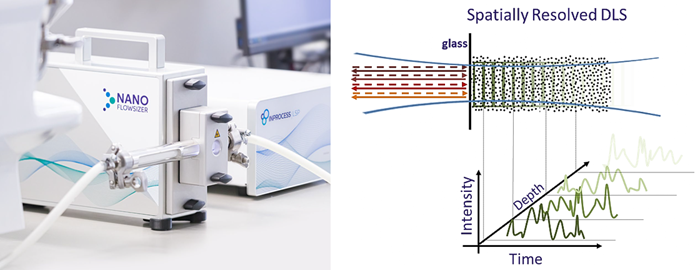
Fig. 1. Left: NanoFlowSizer with an equipped flow cell performing inline SR-DLS particle size measurements. Right: Depth Resolved measurement of backscattered intensity fluctuations, the base of SR-DLS. Image Credit: Image courtesy of Albert Grau-Carbonell et al., in partnership with ELRIG (UK) Ltd.
SR-DLS Measurements of Flowing Suspensions
Using SR-DLS, the NanoFlowSizer (NFS, InProcess-LSP) can simultaneously resolve particle motion due to both Brownian diffusion and fluid flow.
The Poiseuille flow profile that forms under laminar flow conditions (maintained by using an appropriate flow cell) is measured directly and used to compensate for flow effects on the SR-DLS correlations. This patented analysis approach is what enables the NanoFlowSizer’s unique inline sizing capabilities via NFS technology.
As a practical application example, suspensions were measured using the NanoFlowSizer. A pulse-free micro gear pump (type: LP-WT3000-1FB, MS204 gearhead) was used to pump nanosuspension through a 1.5-inch flow cell at rates up to 250 L an hour.
Figure 2 highlights the particle size and velocity profiles measured with the NFS. The mean size (100 nm) is independent of flow within ~2 %, showing the instrument’s ability to measure inflow conditions.
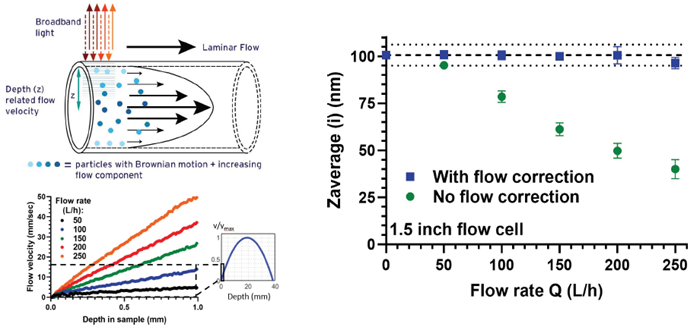
Fig. 2. Left, top: Poiseuille flow profile that develops for laminar flow conditions in the flow cell. Left, bottom: Corresponding velocity profiles of the suspension as a function of depth from the wall of the flow cell. Right: Measured particle size at different flow rates. Image Credit: Image courtesy of Albert Grau-Carbonell et al., in partnership with ELRIG (UK) Ltd.
Real-Time Monitoring of Particle Size During UF/DF for mAb Production
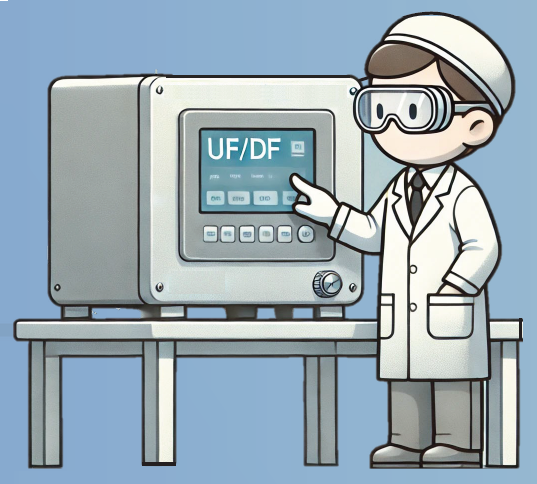
Image Credit: Image courtesy of Albert Grau-Carbonell et al., in partnership with ELRIG (UK) Ltd.
Source: ELRIG (UK) Ltd.
|
Concentration 1 |
DF |
Concentration 2 |
| Nanoscale |
mAb self-association
(size growth; reversible) |
mAb disassociation
(size decrease) |
Large particles
persist and grow |
| Microscale |
Increased particle
formation (>1.5 μm) |
Larger particles
(>1.5 μm) persist |
|
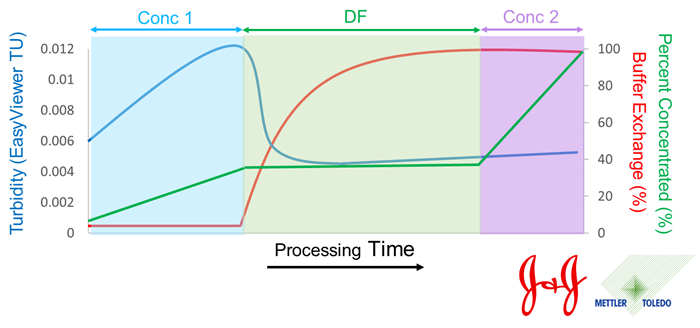
Image Credit: Image courtesy of Albert Grau-Carbonell et al., in partnership with ELRIG (UK) Ltd.
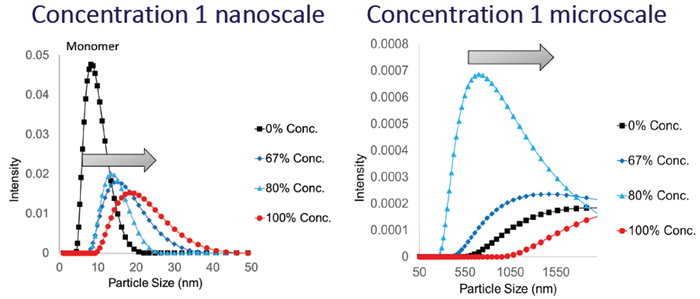
Image Credit: Image courtesy of Albert Grau-Carbonell et al., in partnership with ELRIG (UK) Ltd.

Image Credit: Image courtesy of Albert Grau-Carbonell et al., in partnership with ELRIG (UK) Ltd.
- Reversible mAb self-association through the diafiltration step was within CQA.
- Larger particle formation was seen as early as Conc. 1 processing and can persist through Conc. 2. The NanoFlowSizer helps the early detection of filter fouling issues.
Conclusions
Spatially Resolved Dynamic Light Scattering (SR-DLS) can be used to monitor particle size in flowing suspensions. In this article, this capability was exploited to monitor particle size during mAb UF/DF treatment. The results indicate that during concentration:
- Reversible mAb self-association happens during the first concentration phase
- Formation of larger micron-sized particles that persist (irreversible) happens concurrently
- The NanoFlowSizer enables the early detection of filter fouling issues
About InProcess-LSP
InProcess-LSP, headquartered in Oss at Pivot Park, is a rapidly growing, innovative company founded in 2014. Backed by a team of in-house experts - comprising physicists, chemists, and software engineers - InProcess-LSP is at the forefront of nanotechnology solutions. The company’s leading product, the NanoFlowSizer, is a cutting-edge instrument designed to deliver inline, real-time measurements of nanoparticles in solution, making it indispensable across various industries.
About ELRIG (UK) Ltd.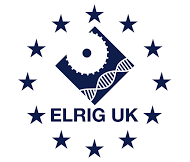
The European Laboratory Research & Innovation Group (ELRIG) is a leading European not-for-profit organization that exists to provide outstanding scientific content to the life science community. The foundation of the organization is based on the use and application of automation, robotics and instrumentation in life science laboratories, but over time, we have evolved to respond to the needs of biopharma by developing scientific programmes that focus on cutting-edge research areas that have the potential to revolutionize drug discovery.
Comprised of a global community of over 12,000 life science professionals, participating in our events, whether it be at one of our scientific conferences or one of our networking meetings, will enable any of our community to exchange information, within disciplines and across academic and biopharmaceutical organizations, on an open access basis, as all our events are free-of-charge to attend!
Our Values
Our values are to always ensure the highest quality of content and that content will be made readily accessible to all, and that we will always be an inclusive organization, serving a diverse scientific network. In addition, ELRIG will always be a volunteer led organization, run by and for the life sciences community, on a not-for-profit basis.
Our Purpose
ELRIG is a company whose purpose is to bring the life science and drug discovery communities together to learn, share, connect, innovate and collaborate, on an open access basis. We achieve this through the provision of world class conferences, networking events, webinars and digital content.
Sponsored Content Policy: AZoLifeSciences publishes articles and related content that may be derived from sources where we have existing commercial relationships, provided such content adds value to the core editorial ethos of AZoLifeSciences which is to educate and inform site visitors interested in life science news and information.
Last Updated: Nov 26, 2025